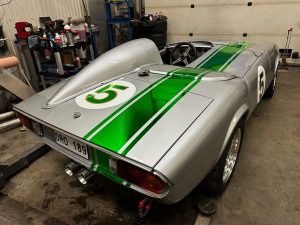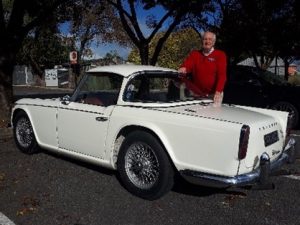Coolest Spitfire Ever
Saturday, November 23rd, 2024Built and maintained by an enthusiast in Sweden, this has to be the the coolest Spitty EVER!



Built and maintained by an enthusiast in Sweden, this has to be the the coolest Spitty EVER!




 Great to see so many members brave the early morning rain and bring out their Triumph’s on Sunday. Best part, all those hours in the shed for a fresh coat of paint paid off, and our Dolly won it’s Pride of Ownership Class. I did enlist the help of my 9yo daughter over the last weeks to help hold,retrieve and fit some parts, with finally her holding the bumpers CAREFULLY without scratching the fresh paint whilst I bolted them up.
Great to see so many members brave the early morning rain and bring out their Triumph’s on Sunday. Best part, all those hours in the shed for a fresh coat of paint paid off, and our Dolly won it’s Pride of Ownership Class. I did enlist the help of my 9yo daughter over the last weeks to help hold,retrieve and fit some parts, with finally her holding the bumpers CAREFULLY without scratching the fresh paint whilst I bolted them up.
Feb 18th (Tuesday Evening) General Meeting at the Sporting Car Club 8.00 pm
Feb 23rd (Sunday) MSCA Picnic / Presentation Day – Virgara Winery, 143 Heaslip Road, Angle Vale . . . from 11.00 am
Mar 2nd (Sunday) – All British Day
Mar 16th (Sunday) MSCA Super Sprint
April 6th (Sunday) TBA Monthly Run instead of the 20th because that is Easter Sunday
Vale: Harris Mann, designer of the Triumph TR7.
The TR Register is deeply saddened to learn of the passing of one of our long-time honorary members and stylist that played a pivotal role in Triumph’s history – Harris Mann who has passed away at the age of 85.
Harris Mann was born in London in 1938 and by the time he arrived at Triumph to style the TR7, had already built up an impressive portfolio of work. He worked at Duple, the (American) Loewy Consultancy. Then after some time out of the country for National Service, Mann worked for Commer and then Ford, where he was involved in the first Escort and Capri. His boss at Ford, Roy Haynes then persuaded Harris to follow him to BMC in 1967, where he moved to lead the design studio at Cowley. Roy Haynes’ brief was to rejuvenate the design team and part of his solution would include Harris Mann.
When the TR7 family was conceived in 1971, Harris was really considered a ‘Longbridge man’ as opposed to a ‘Triumph man’. Once he moved to Longbridge, he shaped the beautiful BMC ‘Zanda’ concept car and put forward acceptable original shapes for the Austin Allegro before these were changed by the British Leyland (BL) planners. Harris was responsible for the wedge-style BL Princess which would be launched immediately after the TR7. The Princess was a large and attractive package which, once again, would have done him more credit if it had not been put on sale when BL was in the depths of its nationalisation crisis.
It was his work on the TR7, where he offered up the shapely wedge-styled shape, which was accepted ahead of Michelotti, Pininfarina and other proposals in a kind of ‘internal’ styling competition. It would be the TR that would outsell all the models that came before and despite a troubled start due to factors out of Harris Mann’s control, would be loved by its dedicated band of enthusiasts for generations.
We interviewed Harris Mann on many occasions in front of audiences at TR events and for TR Action Magazine, and learned much about the detail surrounding the TR7 – why was the screen angled so, why was the rear window glass angled like that, what influenced the nose and flip-up headlamp layout etc – and he was always so honest, modest, and eager to share insights and stories.
Spending time with Harris was to appreciate what professionalism and talent he had, but also what an agreeable and pleasant personality he was. He was so very friendly and easy to get along with. A conversation over lunch though might often be disrupted by him grabbing a beer mat or menu card to draw up some styling detail to explain why things were as they ended up on a particular model.
In the late 1970s, he worked on updates to the Marina style, then the Metro and Maestro projects and the still-born Triumph SD2 saloon project. The entire motor industry recognised his talents, so after he left BL in 1983, to set up on his own, he was never short of work. He shaped several Suzuki motorcycles and worked for BMW on four-wheeler and two-wheeler shapes. Then there was work on big railway locomotives, on Lotus and Lola models, and much more.
Harris found himself back at Longbridge during the early-2000s working with the team headed by Peter Stevens on the MG Zeds and even the MG SV.
For the fans and enthusiasts, the delight of meeting Harris never waned and he always took time to answer in detail even the most naive of questions and explain the reasoning behind designs or to share an anecdote from those troubled times at British Leyland.
He was an active participant in TR Register events, an honorary member of the club and a friend to many of us and he never seemed to tire of seeing the cars being loved and appreciated by enthusiasts, always willing to stop by for a photograph, a ceremonial cake cutting or to sign someone’s boot lid!
Harris Mann, a stylist, a talent, a part of history, a lovely Mann.
This article has been reproduced in part ‘by kind permission of the TR Register UK’ … Dean Bogisch
(0)
Here is photo of Bob Tullius’s Group 44 TR8 Racer. Very successful in it’s day, including a class win in the 1980 Sebring 12 Hour endurance race. Quite a mean machine!

Hi. I’ve missed the last couple of meetings, so this might all be academic, but I recall someone saying that it would be nice to commemorate the 60th anniversary of the Spitfire by having one on the stage during a club meeting. I have a 1963 Spitfire 4 (Mk1)…so its an early model. I’d be happy to do the honours! Let me know and assuming its not poring with rain I can bring it along to the next or other club meeting. I’ll even swap its currently fitted alloys for the original steelies! Cheers. Peter Spalding.
Found these photos recently. I believe it to be a TSOA show from about 1977 or so. I am pretty sure the TR2 RPN843 belonged to a friend of mine Robin Heath while we were doing our engineering degree at the time. It was my introduction to TRs and most of the reason I own one today once I realised that an XK140 was unlikely to happen. Still happy with my choice.
















Our May mid week run, the first for almost 2 years, was enjoyed by a small group of enthusiasts. Bob Kretschmer brought out his lovely TR4A and Stephen Wade his equally superb Stag. The autumn colours in the Adelaide Hills were brightened by the morning sun as the drive took us through Crafers, Woodside, Nairne and to our lunch destination at the Hahndorf Mill. On the way we stopped at Green Valley Strawberry farm for morning tea. All thought this worth another visit, particularly Bob who enjoyed their sticky date pudding.



Last meeting Duane Kaak gave a brief presentation on some personal memorabilia related to his Triumph motoring. I am hoping to continue this whilst members find it interesting. John Tuohy volunteered to present at the next meeting, and I will again seek further volunteers. Just to remind everyone, it is intended that presentations are brief and each item should be smallish and could be anything of interest ranging from a stainless-steel bolt to a speeding fine from SA Police. .
As I am writing, we are 3 days away from the next Berlemon Weekender, this time to Murray Bridge. Julie and I, together with more than 25 others, are looking forward to another interesting event.
At the last meeting it was announced that we have a volunteer to take over the production of FasTRak from Marg and Dean Bogisch who have been doing it for the last 9 years. Many thanks to Marg and Dean for holding the fort for so long and to Katherine Bradley, a relatively new member, for taking on one of the most important jobs in the Club.
And that reminds me that we need a firm commitment from someone to take over running of the Day of Triumph (DOT) from Ian Rigby. This is another vital Club role. Ian has outlined details for the event in a recent FasTRak.and I know that he will be willing to assist a newcomer in taking over and managing the event. Let Ian or me know if you’d like to take on the role.
Don’t forget to pay your subs and get your logbooks sorted before 30 June 2022. And remember the AGM is not far away (August meeting) so start thinking about a position on the Committee.
Check out the social calendar. I look forward to seeing you in June
Kind regards,
Peter Davidge (President)
Just wondering if anybody has had a look at the photos taken by “cars around adelaide “ at the day of triumph recently ?
regards Nathan
March 13th Club sponsored Lunch Run – Meet at 10.30am Civic Park TTG to go to
Bethany for a Club sponsored lunch. Please advise numbers attending.
March 15th General Meeting – Sporting Car Clubrooms 7.30pm
March 20th MSCA Super Sprint – Mallala
April 3rd All Triumph Day – Civic Park TTG
April 10th Club run to St Kilda Tramway Museum – meet at Villi’s Café Blair Athol
10.00am BYO Lunch and drinks – please advise numbers attending.
April 19th General Meeting – Sporting Car Clubrooms – 7.30pm
May 1st MSCA “Peter Hall Memorial 6 Hour Regularity“at Mallala
May 17th General Meeting – Sporting Car Clubrooms -7.30pm
May 28/29th Weekender – details to follow.